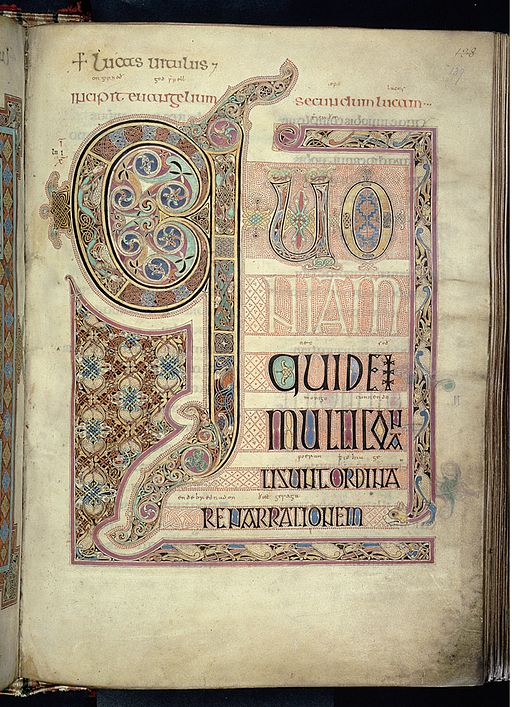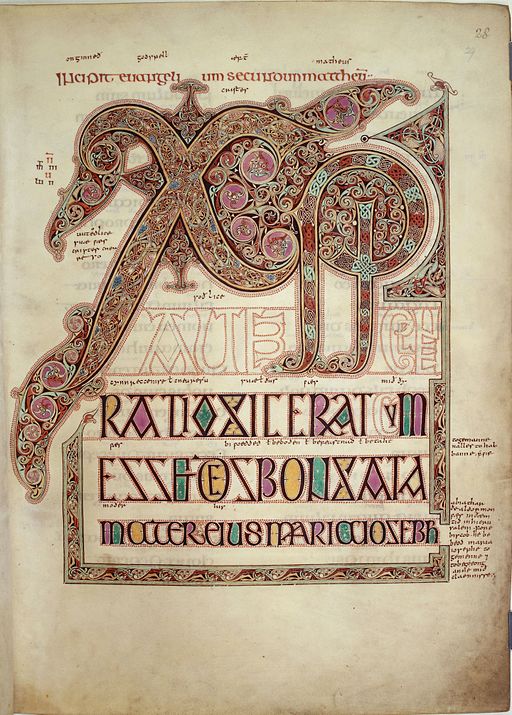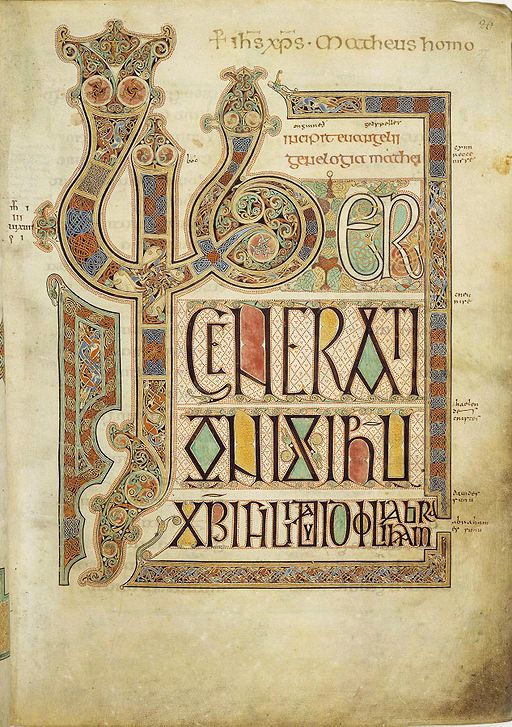
The Lindisfarne Gospels is an illuminated manuscript produced about 715 – 720 in the monastery at Lindisfarne, off the coast of Northumberland. It is an illustrated Latin copy of the Gospels of Matthew, Mark, Luke, and John,
The manuscript is in the unique style of Hiberno-Saxon combining Mediterranean, Anglo-Saxon and Celtic elements.
The Lindisfarne Gospels are presumed to be the work of a monk named Eadfrith, who became Bishop of Lindisfarne in 698. Some parts of the manuscript were left unfinished, indicating that Eadfrith was still working on it at his time of death.
The Lindisfarne Gospels manuscript took approximately ten years to create. Its pages are vellum, made from roughly 150 calf skins. The text is written from dark ink, which contains particles of carbon from soot.
The pens used for the manuscript were cut from either quills or reeds, and there is also evidence of trace marks made by an early type of pencil.
The illustrators manufactured 90 colors with local minerals and vegetable extracts may have been imported some colors from the Mediterranean. Gold is used in only a few small details.
Sometime in the second half of the 10th century, a monk named Aldred added an Anglo-Saxon (Old English) gloss to the Latin text, producing the earliest surviving Old English copies of the Gospels.
A significant portion of the surviving Old English survives between the lines of the Latin manuscript. The gloss provides a simple word-for-word Old English translation of the Latin text to aid the reader.
The Gospels are richly illustrated in the insular style and were initially encased in a beautiful leather treasure binding covered with jewels and metals.

Chi Rho monogram from the Gospel of Matthew in the Lindisfarne Gospels.
Viking Raids on Lindisfarne
In 793, a Viking raid on Lindisfarne caused much consternation throughout the Christian West. The raid is now often taken as the beginning of the Viking Age.
Alcuin, a Northumbrian scholar in Charlemagne’s court at the time, wrote:
“Never before has such terror appeared in Britain as we have now suffered from a pagan race …
The heathens poured out the blood of saints around the altar,
and trampled on the bodies of saints in the temple of God, like dung in the streets.”
The English had turned their back on the sea as they became more settled. Many monasteries were established on islands, peninsulas, river mouths, and cliffs.
Isolated communities were less susceptible to the politics of the heartland. However, the Vikings took advantage of such vulnerable, wealthy, and unarmed settlements.
The 9th-century invasions came from the Danes of the Baltic. The first Danish raids into England were in the Isle of Sheppey, Kent, during 835.
During this period, religious art continued to flourish on Lindisfarne. But by 866, the Danes were in York, and in 873, the army was moving into Northumberland.
With the collapse of the Northumbrian kingdom, the monks of Lindisfarne fled the island.
The Lindisfarne Gospels Survival
During the Viking raids on Lindisfarne, the jeweled cover of the Gospels was lost. Due to Viking raids, the monastic community left Lindisfarne around 875, taking with them the Lindisfarne Gospels.
The Lindisfarne community settled in the Priory at Chester-le-Street in Durham. This is where Aldred completed the interlinear translation of the text.
After Henry VIII ordered the Dissolution of the Monasteries in 1539, the manuscript was separated from the priory. The Gospels were acquired in the early 17th century by Sir Robert Cotton.
Cotton’s library came to the British Museum in the 18th century and went to the British Library in London when this was separated from the British Museum.
Lindisfarne
The Holy Island of Lindisfarne is a tidal island off the northeast coast of England, in Northumberland. Lindisfarne has a recorded history from the 6th century AD, and it was an important center of Celtic Christianity.
The term Holy Island was in use by the 11th century when it appears in Latin as Insula Sacra. The reference was to Saints Aidan and Cuthbert.
The monastery of Lindisfarne was founded circa 634 by Irish monk Saint Aidan, who had been sent from Iona off the west coast of Scotland to Northumbria at the request of King Oswald.
The priory was founded before the end of 634 and remained the only seat of a bishopric in Northumbria for nearly thirty years.
Lindisfarne became the base for Christian evangelism in the North of England and also sent a successful mission to Mercia. Monks from the Irish community of Iona settled on the island.

Gospel of Matthew, Lindisfarne Gospels
Insular Art
Insular Art, also known as Hiberno-Saxon art, was produced in the post-Roman history of Ireland and Britain. The term derives from the Latin term for “island.”
During this period, Britain and Ireland shared a mostly common style different from that of the rest of Europe.
Most Insular art originates from the Irish monastic movement of Celtic Christianity, beginning around 600 with the combining of Celtic and Anglo-Saxon styles.
One major distinctive feature is interlace decoration, in particular, the interlace decoration, as found at Sutton Hoo, in East Anglia.
This style definition is now applied to decorating new types of objects copied from the Mediterranean world, above all the codex or book
The most exceptional period of the style was brought to an end by the disruption to monastic centers and aristocratic life of the Viking raids, which began in the late 8th century.
The best examples of Insular Art include the Book of Kells, Lindisfarne Gospels, Book of Durrow, brooches such as the Tara Brooch and the Ruthwell Cross.
Carpet pages are a characteristic feature of Insular manuscripts, although historiated initials, an Insular invention, canon tables, and figurative miniatures, especially Evangelist portraits, are also familiar in the Insular style.
Cotton Library
The Cotton library is a collection of manuscripts once owned by Sir Robert Bruce Cotton MP (1571–1631), an antiquarian and bibliophile. It later became the basis of what is now the British Library.
After the Dissolution of the Monasteries, many ancient manuscripts that had belonged to the monastic libraries began to be disseminated among various owners.
Cotton was successful in finding, purchasing, and preserving these ancient documents. The library is of special importance for having preserved the only copy of works, such as Beowulf and Sir Gawain and the Green Knight.
Lindisfarne Gospels
- Title: Lindisfarne Gospels
- Also: Cotton MS Nero D.IV
- Date: 715-720
- Culture: Hiberno-Saxon
- Writing: insular script
- Material: vellum
- Type: Ancient Texts
- Museum: British Library
Lindisfarne Gospels
Virtual Tour of the British Library
- Theatrum Orbis Terrarum
- Constitution of the Athenians by Aristotle
- “Newton after Blake” by Eduardo Paolozzi
- The Beowulf Manuscript – Nowell Codex
- Lindisfarne Gospels
The Lindisfarne Gospels
The Lindisfarne Gospels
Virtual Tour of Ancient Texts
- Gilgamesh Flood Tablet – 7th century BCE
- Lament for Ur – 1800 BC
- Law Code of Hammurabi – 1754 BC
- Book of the Dead – Papyrus of Ani and Hunefe – 1250 BCE
- Cyrus Cylinder – 539–538 BC
- The Rosetta Stone – 196 BC
- Constitution of the Athenians by Aristotle – 100
- Vindolanda Tablets – 1st-century
- Codex Vaticanus – 300–325
- Vienna Dioscurides – Juliana Anicia Codex – 515
- Lindisfarne Gospels – 715-720
- Beowulf – Nowell Codex – 975–1025
- Blue Qur’an – 9th – 10th century
- Miroslav Gospel – 1186
- Hadith Bayad wa Riyad – 13th-century
- The Belles Heures of Jean of France, Duke of Berry – 1405
Saint Cuthbert & The Lindisfarne Gospels
The Lindisfarne Gospels
Virtual Tour of Historically Influential Books
- Code Noir – 1687
- “Common Sense” by Thomas Paine – 1766
- “Poems on Various Subjects, Religious and Moral” by Phillis Wheatley – 1766
- Gardner’s Photographic Sketchbook of the Civil War – 1863
- Ancient Texts and Historically Influential Books
Lindisfarne Gospels
~~~
“Behold, the church of St. Cuthbert spattered with the blood of the priests of God, despoiled of all its ornaments; a place more venerable than all in Britain is given as a prey to pagan peoples.”
– Alcuin, Letter to Ethelred, King of Northumbria
~~~
Photo Credit: 1) Unknown but associated with Eadfrith of Lindisfarne / Public domain; Eadfrith / Public domain
Popular this Week








 Sponsor your Favorite Page
Sponsor your Favorite Page SEARCH Search for: Search Follow UsJoin – The JOM Membership Program
Sponsor a Masterpiece with YOUR NAME CHOICE for $5
Share this:
- Tweet
